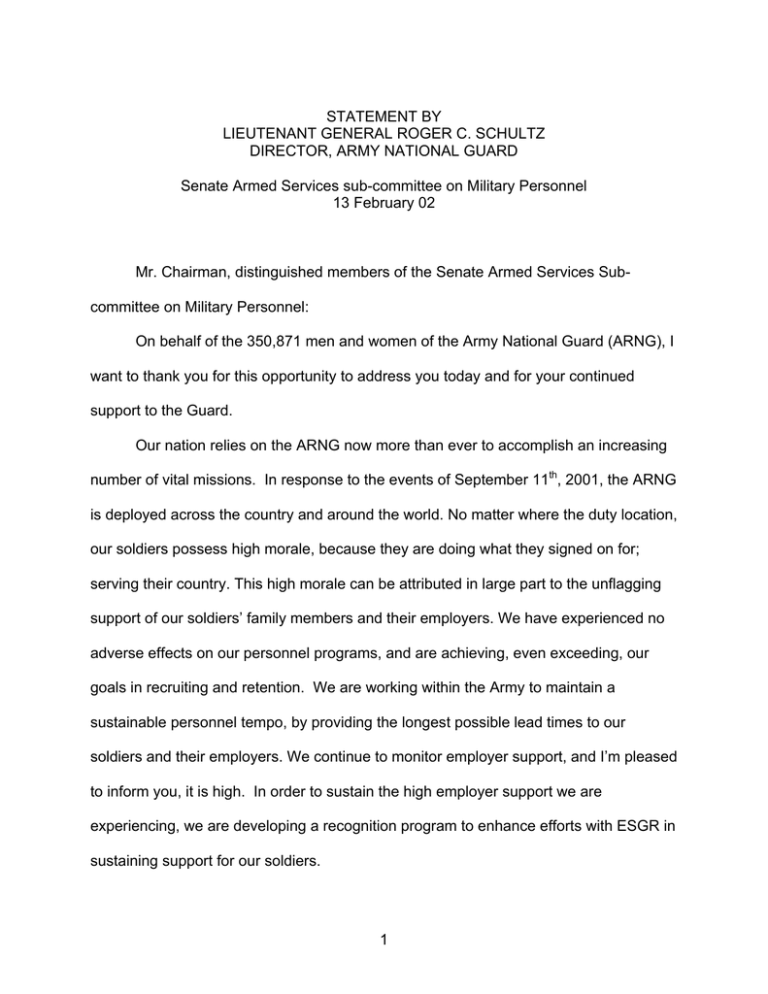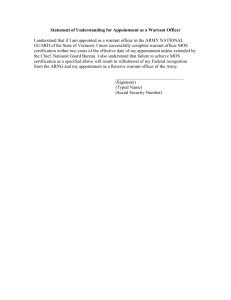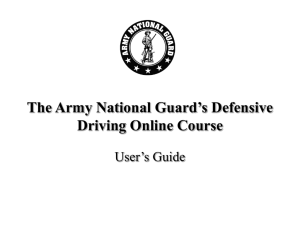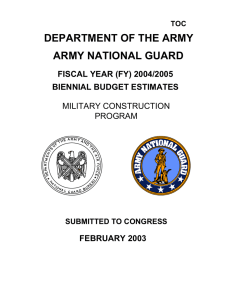STATEMENT BY LIEUTENANT GENERAL ROGER C. SCHULTZ DIRECTOR, ARMY NATIONAL GUARD
advertisement

STATEMENT BY LIEUTENANT GENERAL ROGER C. SCHULTZ DIRECTOR, ARMY NATIONAL GUARD Senate Armed Services sub-committee on Military Personnel 13 February 02 Mr. Chairman, distinguished members of the Senate Armed Services Subcommittee on Military Personnel: On behalf of the 350,871 men and women of the Army National Guard (ARNG), I want to thank you for this opportunity to address you today and for your continued support to the Guard. Our nation relies on the ARNG now more than ever to accomplish an increasing number of vital missions. In response to the events of September 11th, 2001, the ARNG is deployed across the country and around the world. No matter where the duty location, our soldiers possess high morale, because they are doing what they signed on for; serving their country. This high morale can be attributed in large part to the unflagging support of our soldiers’ family members and their employers. We have experienced no adverse effects on our personnel programs, and are achieving, even exceeding, our goals in recruiting and retention. We are working within the Army to maintain a sustainable personnel tempo, by providing the longest possible lead times to our soldiers and their employers. We continue to monitor employer support, and I’m pleased to inform you, it is high. In order to sustain the high employer support we are experiencing, we are developing a recognition program to enhance efforts with ESGR in sustaining support for our soldiers. 1 In order to continue this proud tradition of exceptional service to our nation, the Army National Guard needs your continuing support. Recognizing that your focus is on personnel, I want to make you aware of our program priorities, and provide you with background on what we have identified as critical issues for the Army National Guard. The continued support of Congress is critical in fulfilling our responsibilities and commitment to our nation. . One great asset of the Army National Guard is our extremely dedicated full-time workforce, that small team of Active Guard and Reserve or Military Technicians back home in your communities that look after our units on a day-to-day basis. Full-time manning is our most critical issue, and our number one priority. I want to thank you for your support in increasing the ARNG Full Time manning. In addition full-time support issues can have an adverse impact on retention and the quality of life of our soldiers and their families. With the Guard’s increasing role in worldwide day-to-day operations, it is extremely important to have a sufficient number of full-time soldiers ready to help their units meet current operational tempo readiness needs. National Guard leaders throughout the nation repeatedly cite the lack of full-time support as a significant readiness inhibitor. The Army Guard’s current full-time manning level is 57 percent of Army validated requirements. The additional authorizations for AGR soldiers and military technicians you provided were sent to the States and Territories to improve 2 readiness in units. Those AGR soldiers are on the ground in our armories that facilitate every aspect of readiness by providing the day-to-day support necessary to allow units to perform their operational missions when mobilized. The Army provides funding beginning in Fiscal Year 2005 to continue the momentum you established in reaching our high risk requirement, but more work needs to be done. The Army is seeking additional full-time support authorizations and associated funding to incrementally increase the ARNG full-time support program over the next 11 years. Operational demands on the armed forces have stressed active military forces. Since the end of the Cold War, the armed forces experienced a reduction of total personnel while our security strategy has increased the demands placed on the reserve forces. To meet the increasing mission requirements on the ARNG, we must not only attract but retain our soldiers. Enlisted personnel recruiting and retention were continuing success stories for the ARNG during FY01. Enlisted accessions for the year exceeded the program objective of 60,252 by totaling 61,956 or 102.8 percent of the goal. The overall ARNG loss rate through the end of FY01 was 19 percent, nearly meeting the overall objective of 18 percent. The total officer strength at the end of FY01 was 36,579. Officer endstrength was 821 short of the programmed objective. The ARNG continues to have a higher than expected loss rate among officers. Some of this is attributed to resignation from the ARNG due to family pressures, Operations Tempo (OPTEMPO) and better income opportunities offered in the civilian sector. 3 The shortage of company grade officers in the ARNG, particularly at the rank of captain, results in a large number of lieutenants and warrant officers occupying captain positions. Our company-grade shortfall in units creates a decrease in our overall readiness posture, unit morale and unit effectiveness. The Army National Guard continues to address significant challenges in warrant officer accession and personnel management. Of significant concern is the critical shortage of technical service warrant officers and the impact this has on unit readiness. Currently the assigned warrant officer strength is 81 percent fill of the authorized strength. Technical warrant officer strength is down to 71 percent, while aviation warrant officer strength has fallen slightly below requirements to 95 percent. The ARNG continues to employ a number of measures to combat the critical shortfall in company grade and warrant officers. Measures include developing a robust advertising campaign; creating an officer/warrant officer recruiting and retention course; capitalizing on alternate commissioning sources for increased accessioning into the ARNG; and identifying and resourcing programs to assist in the acquisition of new officers. These initiatives will contribute to our ability to effectively man the force with quality officers and warrant officers. In order to fully capitalize on recruiting and retention successes and improve readiness, an effective and resourced reserve component compatible schools system must be employed. Duty Military Occupation Specialty Qualification (DMOSQ) of individual soldiers is a critical element of Personnel Readiness. The Total Army School System and Distance Learning capability are the Army answers to this challenge. 4 Support for training days for Guard soldiers, distance learning courseware and other training support needs are critical to raising the personnel readiness of ARNG units. The Army’s Personnel Transformation effort will merge personnel and payroll programs and databases across all components and provide greater accuracy and integration. The ARNG supports the Personnel Transformation effort and would encourage support for the program. Today, the Army National Guard is on duty in 57 countries. Operations in FY02 are dramatically illustrating the increasing role of the Army National Guard in supporting theater Commanders-in-Chief (CINCs) in Stability and Support Operations. To date this fiscal year, the ARNG has provided approximately 31,770 soldiers to the CINCs, representing an increase of 23,829 soldiers from FY 01. This includes support to the Olympics, Overseas Deployment Support, Temporary Tours of Active Duty, Presidential Reserve Call-Ups, and Partial-Mobilization. To meet the needs of the future, the ARNG must provide our soldiers with the resources they need to remain trained and ready. The Army National Guard must anticipate the requirements of today’s world while we plan for tomorrow’s challenges. In addition, the ARNG will have a major role in supporting domestic civil support missions, including such diverse tasks as managing the consequences of Weapons of Mass Destruction, National Missile Defense Systems and other threats to our nation. The Army National Guard is clearly an essential force in America’s military. We must, however, continue to strive forward in order progress and sustain both national and civil support initiatives. The future will demand an ever-increasing OPTEMPO. Your continued support ensures that we maintain our momentum and meet those 5 demands. Your help in supporting these issues is greatly appreciated by the National Guard as a whole and in particularly by those soldiers in your home districts. 6




